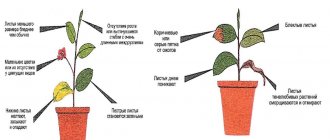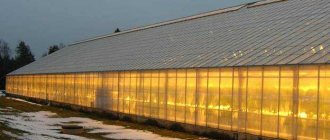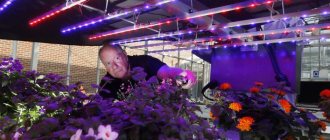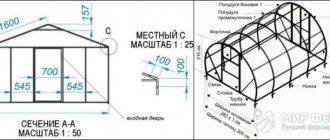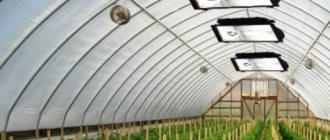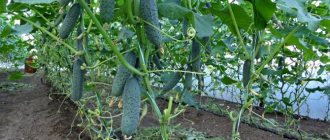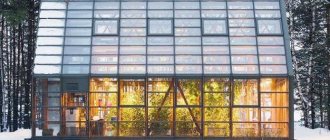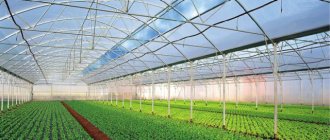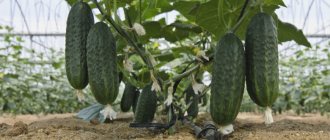To grow plants in winter, it is important not only to create the necessary microclimate: temperature and humidity, but also to organize the correct lighting of the greenhouse. Due to the lengthening of the dark time of the day, short daylight hours are clearly not enough for healthy growth of crops. To protect plants from diseases, increase ripening time, and increase productivity, special LED lamps are installed that emit light in the required spectrum.
LED lamps for greenhouses are becoming increasingly common. They have a number of advantages over their predecessors: neon gas-discharge, nitride or fluorescent backlights.
LED lighting for greenhouses
The advantages of LED emitters and their features will be discussed below. In addition, recommendations for calculation are provided.
Advantages of greenhouse lighting with LEDs
The main advantage of LED lighting in greenhouses is the ability to create the necessary balance of blue and red spectrum, which makes their use a universal solution for all types of crops and flower plants. Structurally, this is achieved by combining different types of emitters in one housing.
Other positive characteristics of LEDs for greenhouses include:
- Low power consumption;
- high luminous flux intensity compared to other types of lamps;
- long service life, up to 80 thousand hours or more;
- Efficiency from 95%;
- low ripple;
- safety for humans and the environment: LED does not emit ultraviolet radiation, does not produce ozone and does not contain mercury and other harmful substances.
LED lamp for greenhouses
The importance of light for plants
The main conditions for the development of any vegetation are warmth, light and water. Due to these biological characteristics, vegetative processes are impossible during short winter days. The fact is that natural or artificial light gives the stems energy for growth.
Thus, entire chains of organic reactions arise from the simplest molecules. When photons of rays hit the surface of the foliage, they trigger the biochemical interaction of its components, resulting in the growth of the root system and above-ground biomass of the crop, that is, photosynthesis.
Did you know? The color of plant biomass is due to the fact that during the growth process they reflect green light and absorb rays of other colors for photosynthesis. If you place a growing stem under a green lamp, it will wither.
The consequences of light deficiency for plants can be:
- thinning and stretching of cuttings;
- fragility and fragility;
- leaf deformation;
- growth inhibition;
- yellowing of the root layers of biomass.
Because of this, a florist or gardener who has acquired a greenhouse should arrange artificial lighting in advance.
After all, without it, the laying of buds and fruits is impossible. In this case, it is important to focus on the light type of the crops being grown. They are:
- Short daylight hours. These are plants that came to our latitudes from the tropics and subtropics. For the formation of their flower stalks, it is important that the night lasts at least 12 hours. This type includes: cucumbers, beans, eggplants, bell peppers, zucchini, melons, tomatoes, basil, pumpkin, sesame seeds, etc.
- Long daylight hours. Representatives of flora characteristic of northern and temperate latitudes were included here. They can develop fully only with daily illumination lasting at least 13-14 hours - otherwise there will be an intensive increase in biomass without flowering and fruiting. We are talking about celery, rutabaga, beets, carrots, potatoes, cabbage, onions, radishes and radishes, lettuce, spinach, dill, parsley, parsnips, etc.
- Neutral. They are distinguished by active budding and ovary formation without a pronounced dependence of the duration of day and night. This group includes: the majority of varietal and hybrid crops zoned for mid-latitudes.
Did you know? A century-old lamp in a California fire station has been burning continuously since 1901 and is considered the longest-lasting in the world.
LED illuminator device
LED lamps for greenhouses consist of semiconductor emitters of the red or blue spectrum, assembled in one circuit. In small lamps, phytodiodes are connected in series, in large lamps - in series-parallel. Since powerful LED elements become very hot during operation, they are placed on a heat sink - a duralumin plate. Read more about the calculation and production of radiators for LEDs.
Power is supplied through a driver - a device equipped with a pulse voltage rectifier and a current limiter (how to make a driver). Some models are also equipped with a microcontroller with which the lamp is controlled: the on and off time is set or the intensity of the light flux is adjusted.
All lighting components are placed in a sealed housing. A transparent diffuser made of optical polycarbonate is installed on the working side (how to make a diffuser). Connection to the network is made directly using a power cable, without intermediate equipment.
Design of greenhouse LED lamp
A good comparison of LED lamps for greenhouse lighting:
How to manage lighting correctly
According to research, red light is recommended during the active flowering period, and blue light is suitable for growth. But this does not mean that plants should be left without natural light. Artificial lighting during prolonged exposure causes negative changes in plants and contributes to stress. Therefore, the owner should worry about proper planning of the greenhouse in advance, and then in winter it will be possible to harvest an excellent harvest of cucumbers and tomatoes.
Experienced owners advise not to leave the lamps on around the clock, because 6 hours is enough for plants. Other tips for improving the conditions for greenhouse development can be read on the forums.
Calculation of LED lamps for greenhouses
If you plan to independently organize artificial lighting, before designing and making calculations, you should consider the following data:
- Height of placement of lamps;
- power of lamps used;
- variety of plant being grown - the required lighting intensity for different types of crops is not the same;
- area of the illuminated area.
Knowing this information, you can proceed to calculations. To calculate LED lighting for greenhouses, a simplified formula is used:
F = (E * S) / CI
In this formula, F is the intensity of the luminous flux, Lm; E — illumination level, Lux; S—area of the illuminated area, sq.m; CI – luminous flux utilization coefficient. The coefficient value is 0.4 for systems with an external reflector and 0.8 for systems with an internal one.
Example of calculation of greenhouse lighting
Since in our case the greenhouses are illuminated with LED lamps, the calculation will involve the use of a standard dependence of the luminous flux on electrical power. The manufacturer's error can be neglected.
| Dependence of luminous flux on LED lamp power | |
| LED lamp power, W | Luminous flux, Lm |
| 2-3 | 250 |
| 4-5 | 400 |
| 6-10 | 700 |
| 10-12 | 900 |
| 12-15 | 1200 |
| 18-20 | 1800 |
| 25-30 | 2500 |
Example . It is required to illuminate an area of 10 square meters of greenhouse tomatoes with a minimum acceptable level of 6000 Lux.
Calculation . In the case of using luminaires with an internal reflector, the following calculations are obtained:
F = (6000 * 10) / 0.8 = 75000 lumens.
Those. the required total luminous flux is 75000Lm. Using the table, the number of lamps of a certain power required to complete the task is determined: 30 pieces of the 25-30 watt category.
Similar actions are performed for models with external reflectors, substituting the corresponding coefficient - 0.4.
Important! The luminous flux we obtained is 75,000 lm based on a lighting placement height of 1 m. The installation height of LED lamps for greenhouses is determined by an empirical method.
When increasing/decreasing the height of the placement of lamps, the luminous flux changes according to the inverse square rule . With a lighting height of 2m, the illumination at ground level will drop by 4 times; 3m - 9 times; 0.5m - will grow 4 times, etc.
It should also be taken into account that as the installation distance decreases, the useful lighting area decreases. Sometimes finding a compromise takes quite a long time, and the fact of incorrect suspension is detected by the external signs of the plants.
External signs of lack or excess of light for plants
For this reason, when placing artificial lighting in greenhouses with LED lamps, it is advisable to provide for the possibility of subsequent height adjustment.
Lamp selection
In the cold season, the duration of daylight hours is insufficient for the full development of plants, so additional lighting in the greenhouse is necessary in winter. Today the market is not able to offer a universal solution. To create comfortable conditions in the greenhouse, you should select several types of lamps. A balanced system will allow you to grow a bountiful harvest all year round.
Specialized stores offer a wide variety of lamps for greenhouses; how can you choose the right one and not get lost in this variety if marketers praise the products in every possible way? To do this, you should study the main characteristics of the lamps.
How to make lighting in a greenhouse, diagram for Dnat lamps
Incandescent lamp
Incandescent lamps provide excellent illumination of the greenhouse and serve as a slight heating for the air. But they are not economically profitable: too much energy consumption. The spectrum of incandescent lamps is 600 nm, which is not at all conducive to the normal development of plants. If such lighting is abused, plants get burned, as an excess of orange, infrared, and red rays are formed. The stems stretch unnaturally, and the leaves become deformed.
Fluorescent lamps
Fluorescent lamps have a favorable spectrum for growing plants. They are durable, relatively inexpensive, and the heat transfer of such lamps is very low. The principle of operation is identical to light-saving ones, but the latter are capable of illuminating only a small area.
Fluorescent lamps are installed in special metal boxes, less often vertically in plastic lighting fixtures.
Ultraviolet lamps for greenhouses
Modern ultraviolet lamps operate on the principle of fluorescent lamps: UV radiation is generated in the bulb due to the interaction of an electromagnetic discharge and mercury. A gas discharge tube is made from uviol or quartz glass, which has the properties of transmitting UV rays. Uviols are safer because they reduce the level of ozone formation. By adding different components during glass production, manufacturers create lamps that operate in a strictly specified range, so that a favorable lighting spectrum can be selected.
Lighting in a polycarbonate greenhouse with ultraviolet lamps
Mercury vapor lamps
DRL high pressure mercury lamps. They heat up quickly and emit rays from the near ultraviolet spectrum. Such lighting is useful for improving photosynthesis in very small quantities, combined with sunlight. Recommended for use during fruit ripening. Not safe, operation is possible at a stable voltage, differences cannot be more than 5%.
Using mercury lamps in a greenhouse
Sodium lamps
High pressure sodium lamps (denas, dnas, dnat). Very economical, with high heat output, it is effective to use lamps with a power of more than 400 W for greenhouse lighting. Sodium lamps for greenhouses create orange-red monochrome lighting similar to that of the sun. The downside of the lamps is that there are few blue rays. Manufacturers have improved the product; now you can buy an improved version of lamps for greenhouses with more intense rays of the blue spectrum. Experts have noticed the ability of sodium lamps to attract insect pests, which is a significant obstacle to their use in a greenhouse.
The photo shows a sodium lamp
LED bulbs
LED lamps for greenhouses (LED) individually create monochrome lighting, but a huge range of products allows you to choose a combination of LEDs and create a favorable spectrum individually for each type of plant. LEDs for greenhouses are economical, durable, and work properly at low voltage. The light intensity can be adjusted by the number of lamps and by placing the lamps at different heights. When seedlings grow, it is better to illuminate the greenhouse with blue-spectrum LED lamps; for fruit ripening, orange and red segments of rays should be used.
Professional LED lamps for greenhouses – illumination in several spectra
Infrared lamps for greenhouses
Infrared lamps and heaters are used to heat greenhouses. These are energy-saving systems that create favorable conditions for plant growth, similar to natural ones. For more efficient use, the devices are equipped with regulators, manual or automatic, so that the microclimate can be completely controlled. If convective heating first warms the air, then infrared heating acts on plants and soil, and then they release heat into the air.
Equipment recommendations
A few must-have tips when installing LED lighting in a greenhouse.
- Choose models of phytolights with the ability to adjust the density of the light beam and switch the “red-blue” spectrum. They are universal and can be adjusted for any plant.
- Use reflectors and reflectors. With their help, the number of required emitters is reduced, which reduces the cost of LED lighting in greenhouses and its subsequent operation.
- Turn on the backlight only when needed. Excessive light is no less harmful than its lack. In winter, greenhouse lighting should be on for about 12-16 hours a day, depending on the plant variety.
- Try to get by with fewer lamps. It is better to install one that matches the characteristics than several less powerful ones.
- For the proper development of crops, sunlight is also necessary. No matter how perfect the lighting is, it cannot replace natural lighting. Strive to get the most from the sun's energy. Do not place the greenhouse in shady areas or block it from sunlight.
- In some cases, for example, for large greenhouses and conservatories with many different types of plants grown, it is advisable to use combined lighting. By combining greenhouse LEDs with other types of lamps, you can achieve the most acceptable result.
- LED lighting for greenhouses is especially useful in the off-season.
Don't forget about safety . Greenhouses are places with an increased risk of electric shock. It is advisable to lay all power cables in special channels that protect them from mechanical damage and humid environments.
All inputs and connections must be carefully insulated and sealed against moisture. It is good to use a three-wire connection circuit with protective grounding to avoid accidents.
Please rate the article. We tried our best:)
Did you like the article? Tell us about her! You will help us a lot :)
Which lamps can be used in which case?
To illuminate one plant, you can use a 20-30 W lamp suspended at a height of 5 to 30 cm.
Groups of plants are illuminated with lamps with a power of 50 W (from a distance of 40-60 cm) or a power of 15-100 W, from a distance of 50-100 cm - depending on the size of the group.
Powerful lamps from 250 W are best placed at a height of 1-2 m in large rooms. And sources of 400 W and above are used to illuminate winter gardens or greenhouses; they will be too bright for the room. In addition, when using high-power lamps, it is necessary to calculate the wiring to prevent overloading the system.
It should also be noted that using many lamps instead of one is impractical. Especially older incandescent lamps with large diameters. They will start to overheat and quickly fail. Electricity costs will also increase. It is better to use sources with a reflector or install reflective wall coverings.
When using grow boxes or grow tents, you should not choose high-power, sodium or incandescent lamps, as they get too hot. And the interior finishing with a reflective coating makes the illumination much brighter. But in each case it is necessary to use a lux meter.
CALCULATION OF ILLUMINANCE FOR PLANTS
Plants need light for normal growth. It’s no secret that without a sufficient amount of light, a plant will not only bear fruit, it will not even be able to grow. The data on the illumination of plants from the list assumes that what is being calculated is “additional illumination”, i.e. used as a complement to natural light.
At the moment, the most optimal lamps for supplementary lighting when growing plants are considered to be high-pressure sodium arc tube lamps (HPS).
Most often, for supplementary lighting in greenhouses, DNa3 lamps (high-pressure sodium arc mirror lamp) are used; the efficiency of its reflective layer is usually higher than a conventional reflector in lamps.
Despite the fact that these lamps are very well suited for growing most plants, do not forget that for some crops it is still better to use other lamps with a predominance of a different spectrum.
If you plan to grow greens (parsley, dill, basil), then it is better to use DriZ lamps (high-pressure mercury arc metal halide mirror lamp), since it has a very high component of the blue spectrum (for vegetative growth).
Also suitable for additional lighting are fluorescent lamps.
The level of lighting required for high-quality growing of plants is regulated by agronomic standards, the minimum acceptable is 6 - 7 kLk (kilolux).
Based on the standard indicator, the intensity and duration of additional lighting of the greenhouse is calculated. In autumn, spring less, in winter, respectively, a longer period is required.
To achieve a minimum of illumination, lamps for greenhouses are suitable, the specific power of which is 50-100 W/m2. The number of lamps is determined when designing a lighting system based on calculations for an individual project. You can perform the calculations yourself using an online calculator. A good harvest is guaranteed at an average illumination level of 10-12 kLx, up to 20 kilolux.
Calculation of illumination depending on the distance of the lamp to the plants
Example:
If the illumination at a distance of 1 m from a light source is 1000 lux, then at a distance of 2 m it is already 250 lux, see the table:
Proper illumination of seedlings in a greenhouse with a phytolamp
Phytolights are installed above the plants. Installing phytolamps in greenhouses on the side leads to bending of the stems and their fragility, including under the weight of the fruit. If the height, power and spectrum of the phytolamp are selected correctly, then the crops will have a healthy, well-groomed appearance.
To properly illuminate the seedlings, powerful phytolamps with a different spectrum of exposure are installed in the greenhouse, based on the characteristics of the plants being grown, the season, the type and shape of the lamps and the required illumination area.
Plant lamps OSRAM PLANTASTAR from ElectroPara store
Reviews:
uoar rus
writes: Does a phyto lamp with an E27 base from China work for plants?
DRL Abelman
writes: You can’t grab the flask with your hands, otherwise it’s like f*ck! and you ????????
et2mk
writes: how much power will this HPS consume? Electricity bills will probably be amazing if you use a 400W lamp around the clock
uoar rus
writes: Does a phyto lamp with an E27 base from China work for plants?
DRL Abelman
writes: You can’t grab the flask with your hands, otherwise it’s like f*ck! and you ????????
Illumination of plants, seedlings. Overview of all types of lamps for illuminating plants.
Reviews:
Edward Bond
writes: Hello! Can you order these light bulbs?
Serj Vaneev
writes: Tell me, can this LED be used instead of daylight on an ongoing basis, given that the plants are grown in the basement????
rin org
writes: EEE EEE EEE take that out of your speech
GrowByLEDs.com
writes: Hello! Can I send you a lamp for testing? I make them myself (video on assembly is on my channel)
Vadim Xvost
writes: Illiterate speech is very distracting (incandescent lamps, especially) and the pop-up window from windows
First, you should ask the manufacturer of the lighting fixture. Well-known brands guarantee quality and customer service (which is sometimes expensive). Chinese lamps are presentable mainly due to their low price, but, unfortunately, you will not receive any guarantees or service.
It should be admitted that today a lamp for a greenhouse has not yet been created that is capable of 100% transmitting the range of the sun's rays. Therefore, experienced owners often combine lamps to achieve the best results. Biological scientists have been able to establish that different light ranges will have different effects on the crops being grown.
Norms and requirements
Plants react differently to light radiation. Therefore, before purchasing and installing phytolamps in a greenhouse, you need to know what spectra crops need for growth and development.
Yellow and orange light 600-620 nm is not suitable for flowering and fruit-bearing plants. However, it stimulates the elongation of stems in ornamental crops. Red spectrum 630-660 nm – necessary for any plants at all stages of growth for accelerated development, flowering and fruiting. Blue light 400-520 nm also stimulates the growth and development of crops, activating photosynthesis processes. Strengthens the root system, increases green mass. Green spectrum 500-600 nm - in combination with blue light, promotes the formation of chlorophyll in chloroplasts and the accumulation of vitamins. However, if you install only green spectrum phytolamps, this can harm the plants. Ultraviolet 280-400 nm – increases green mass and strengthens the root system of crops. In addition, under the influence of ultraviolet radiation, harmful bacteria die and plants grown in greenhouses develop better and faster. Infrared light from 780 nm is close to sunlight, thanks to which plants quickly grow, bloom and bear fruit. However, long-term exposure to such radiation is detrimental to most crops. Violet spectrum 400-430 nm - through this lighting, plant trunks are strengthened and their resistance to external factors increases.
To select a phytolamp, you should pay attention to the spectrum it emits. Many modern models combine a combination of several types of lighting. Then it all depends on the type of plant being grown and the result you want to achieve. You can install different phytolamps in a greenhouse and see how they affect crops.

